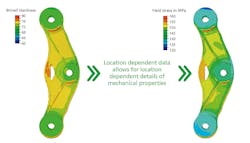Structuring Material Research for a Continuous Data Space
For manufacturers and others that develop, produce, or select materials, the great opportunity of digitalization is the potential for “cross-process linking” of material data. Theoretically, it would shorten component development times, optimize manufacturing processes, and promote more reliable plant operation. The problem is that material data records are highly heterogeneous, which can make linking details of one material to other data extremely complex.
A research project led by the Fraunhofer Institute for Mechanics of Materials (IWM) in Freiburg, Germany, is making progress in structuring materials data into a “continuous data space.”
“Due to their complexity, materials data are extremely heterogeneous and also change continuously during the product life cycle,” explained Dr. Christoph Schweizer of IWM, the project coordinator. “The fact that they vary locally within a product and in some cases cannot be determined non-destructively via measurement technology makes their structuring, storage, and linking quite demanding.”
Manufacturers, as well as researchers or product designers, among others may wonder how to gather all the data relevant for their work. The “MaterialDigital” research project initiated in 2018, together with seven other research bodies involved in metallurgy, chemistry, physics, and computer science, are pursuing an answer to that question, and more. What infrastructure is needed to establish such a database – or “data space”? How should the integration of data begin?
An application case coordinated by IWM concerned gravity diecasting of aluminum parts, for which it developed the necessary basic principles such as software tools for structuring the data and automating the workflows. Based on these, they created a prototype material data space.The research partners also demonstrated the benefits of digital value-added chains. With the help of real material and process data, the researchers were able to use a digital twin to handle more complex simulations and at the same time predict component properties.
“Based on data-space queries, quick and precise decisions can be made in companies in which materials play a prominent role instead of having to go through expensive and time-consuming trial and error loops,” Schweizer said. “Our data space architecture is designed in such a way that it can be easily transferred to other material processes.”
Tools and workflows are available to interested industries that can adapt them to their specific needs. The materials data structured in the diecasting use case will be published by the consortium as a best practice example.
A separate IWM program based on the MaterialDigital project began immediately. “Further research potential of the materials data space lies in particular in integrable logics and the exploitation of machine learning,” he said. Specially designed computer models could be used to read out and make use of laws not yet stored in the process graphs. This would allow far more specific predictions to be made while the modeling steps can be minimized.
A central concern was to develop the technical foundations and workflows for the materials data space based on established standard formats. “In developing a uniform data structure for material-intensive processes, we had to start practically from scratch, because there was virtually no preparatory work,” Schweizer explained.
Using the basic structure of ontology and knowledge graph, the researchers were initially able to describe individual process steps of the use cases -- “process modeling”. In the next step, the individual processes were connected to each other according to their chronological sequence in the real process chain, to form a virtual network. In this final materials data space, not only are the process descriptions and their metadata available, but the raw data can be accessed automatically via links, so that a variety of evaluations are possible.
So that laypersons also can contribute data, the researchers programmed an app with which the modeled process graphs can be converted automatically into an Excel template. This file can be filled by hand if necessary and require no previous knowledge of data spaces.
Schweizer and his colleagues proved that this structured and comprehensively linked knowledge base adds value by integrating experimental data and simulations. For a cast part, they created a digital twin that exploits the relationship between the locally different solidification during casting and the locally varying hardness, to build up a simulation model with heterogeneously distributed mechanical properties. Using insights from the data space, the simulation model can be fed with precisely selected material parameters that recognize the casting specific chemical composition and heat treatment.
Based on the digital twin, the researchers were able to predict the functional mechanical properties of the casting demonstrably more precisely than with batch-independent material parameters.

